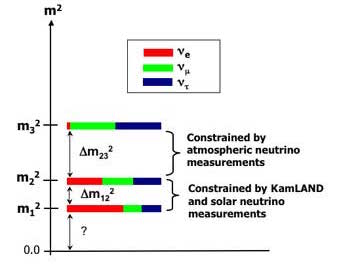The Effects of Neutrino Decay on Oscillation Probabilities
Kayla Leonard, Dr. André de Gouvêa
.
| Abstract | About the Neutrino | Neutrino Decay | Contact |

What do we know about particle physics?
Most of what we know can be described by The Standard Model of particle physics, summarized in the image to the right. It includes the most fundamental particles in the Universe and explains how the particles interact with each other. However, this model does not yet explain everything it should, so it is not complete.
What are neutrinos?
Neutrinos are tiny elementary particles. They have very little mass and no electrical charge. This makes them very hard to detect, so there is still a lot to learn about them. They come from many places, including our Sun, cosmic rays interacting with Earth's atmosphere, distant supernovae, nuclear reactors, and more.

What are neutrino flavors?
There are 3 types, or flavors, of neutrinos. They are the electron neutrino, muon neutrino, and tau neutrino. These flavor states are different combinations of the 3 neutrino mass states, vi. For example, the electron neutrino is made up of a specific "amount" of v1, v2, and v3. In the figure on the right, each color represents a flavor state. You can see what fraction of mass state makes up each flavor state.
What are neutrino oscillations?
We know from quantum mechanics that the Hamiltonian, or system energy, evolves the states. This means that over time, there are different amounts of v1, v2, and v3 present. Thus the flavor of the neutrino is also changing. These changes in flavor are called oscillations. We can measure oscillations by the probability that a neutrino will have changed flavor after traveling a certain distance L.
What does a typical neutrino oscillation experiment look like?

Let's say we begin with a beam of muon neutrinos. If we put a detector 500 miles away, we can measure the beam and determine what type of neutrinos are in the beam now. If the beam is now only 80% muon neutrinos and is 20% electron neutrinos, then there is a 20% chance that a muon neutrino will have oscillated after 500 miles. Learn more about the NOvA Experiment here.
What is neutrino decay?
We considered the hypothesis that there may be more than three flavors of neutrinos. The new flavors would be very light, and it may be possible for "regular" neutrinos to decay, or turn into, these new lighter states.
What would this change?
Neutrino decay would change the probabilities observed during neutrino oscillation. We calculated these new probabilities and determined what constraints we could place on measurable parameters.
. Kayla Leonard
. Northwestern REU Student 2015
. Student at University of Texas at Austin